ISSN ONLINE(2319-8753)PRINT(2347-6710)
ISSN ONLINE(2319-8753)PRINT(2347-6710)
| S.Narasimha Kumar Asst. Professor, Department of Mechanical Engineering, CBIT, Gandipet, Hyderabad- 500075, India |
| Related article at Pubmed, Scholar Google |
Visit for more related articles at International Journal of Innovative Research in Science, Engineering and Technology
Automobiles have become critically indispensable to our modern life style. On the other hand, future of automobiles, built on the internal combustion engines, has been badly hit by the twin problems due to diminishing fuel supplies and environmental degradation. Thus, it is very important to identify some clean-burning, renewable, alternative fuels to ensure the safe survival of internal combustion engines. In the present paper investigations were carried out to evaluate the performance of two-stroke, single cylinder spark ignition (SI) engine with alcohol blended (80% gasoline and 20% ethanol by volume) having copper coated combustion chamber [copper-(thickness, 300 μ) coated on piston crown, and inner side of cylinder head]. Performance parameters [brake thermal efficiency, exhaust gas temperature and volumetric efficiency] were determined at various values of brake mean effective pressure of the engine, while combustion characteristics [peak pressure, maximum rate of pressure rise, time of occurrence of peak pressure and maximum heat release] were evaluated at full load operation of the engine with alcohol blended gasoline. Comparative studies were made on performance parameters and combustion characteristics with conventional SI engine with pure gasoline operation. Brake thermal efficiency increased with alcohol blended gasoline with both versions of the combustion chamber. Copper-coated combustion chamber (CCCC) showed improved performance and combustion parameters when compared with conventional engine (CE) with both test fuels.
Keywords |
| S.I .Engine, Copper coating, Performance, combustion characteristics |
INTRODUCTION |
| This section deals need and necessity of alternate fuels for SI engine, experimental investigations taken up by different researchers connected to this work, methods to improve the performance of SI engine, modification of combustion chamber, change of fuel composition, research gaps and objectives of the experimentation. The large amount of pollutants emitting out from the exhaust of the automotive vehicles run on fossil fuels are increasing and these pollutants are proportional to number of vehicles. The civilization of any country is measured on the basis of number of vehicles. Hence the Government has to spend huge foreign currency for importing crude petroleum to meet the fuel needs of the automotive vehicles, in the context of fast depletion of fossil fuels. In view of heavy consumption of gasoline due to individual transport, the search for alternate fuels has become pertinent apart from effective fuel utilization which has been the concern of the engine manufacturers, users and researchers involved in combustion & alternate fuel research. |
LITERATURE REVIEW |
| Alcohols are suitable substitutes as alternate fuels for use in SI engines, as they have properties compatible to gasoline fuels, that too their octane rating is more than 100. If alcohols are blended in small quantities with gasoline, no engine modification is necessary. Engine modification and change in fuel composition are two methods to improve the performance of the engine and reducing pollution levels. Engine modification [1-3] with copper coating on piston crown, and inner side of cylinder head improves engine performance as copper is a good conductor of heat and combustion is improved with copper coating. The use of catalysts to promote combustion is an old concept. More recently copper is coated over piston crown and inside of cylinder head wall and it is reported that the catalyst improved the fuel economy and increased combustion stabilization. Nedunchezhian et al.[1] evaluated the performance of a two-stroke copper coated engine (copper coating of thickness 300 microns and binding material of thickness of 100 microns on piston crown and inside portion of cylinder) with pure gasoline and reported that CCCC improved the specific fuel consumption by 4% at full load operation of the engine . Murali Krishna et al. [3] conducted experiments on four-stroke copper coated combustion chamber (CCCC) (copper coating of thickness 300 microns with binding material of thickness 100 microns on piston crown and inner side of cylinder head) with gasohol (20% ethanol blended with gasoline by volume) and reported that CCCC increased efficiency of the engine by 20%. Murali Krishna et al. [4] employed four-stroke variable compression ratio (3-9) SI engine ranging from, variable speed (2200-3000 rpm) with methanol blended gasoline (20% by volume) and reported increase of thermal efficiency by 15% in comparison with pure gasoline operation on conventional engine. Investigations have been carried out by different researchers [6-9] to improve the performance of SI engine with change of fuel composition. |
| Farayedhi et al. [5] investigated the efficiency of CE with oxygenated fuels of ethanol and methanol used as blends of 10, 15, and 20 % by volume with gasoline and it was reported that these blends improved brake thermal efficiency. The leaded fuel performed better than the oxygenated blends in terms of the maximum output of the engine except in the case of 20 % by vol. methanol and 15 % by vol. ethanol blends. Overall, the methanol blends performed better than the other oxygenated blends in terms of engine output and thermal efficiency. Ceviz et al. [6] reported the effects of ethanol-unleaded gasoline blends on cyclic variability in an SI engine. The results showed that the coefficient of variation in indicated mean effective pressure (IMEP), CO and UBHC emissions decreases by using ethanol-unleaded gasoline blends as a fuel, while CO2 concentration increased with 10 % ethanol (by vol.) fuel blend. |
| Bahattin [7] conducted experiments on SI engines with blends of E25 (75% gasoline and 25% ethanol by vol.), E50, E75 and E100 fuels at a constant load and speed. The experimental results show that the most suitable fuel in terms of performance and emissions was E50. Then, the compression ratio was raised from 6:1 to 10:1. The engine was tested with E0 fuel at a compression ratio of 6:1 and with E50 fuel at a compression ratio of 10:1 at full load and various speeds without any knock. The cylinder pressures were recorded for each compression ratio and fuel. The experimental results showed that engine power increased by about 29% when running with E50 fuel compared to the running with E0 fuel. Also, the specific fuel consumption and CO are reduced. |
| Al-Baghdadi [8] carried out investigations on blends of ethanol with gasoline 30% by volume and reported that these blends increased engine power, thermal efficiency and reduces the nitrogen oxides, CO and HC emissions. Investigations were carried out [9-10] conducted experiments on two-stroke copper coated (thickness of copper coating- 300 microns- coated on piston crown and inside portion of cylinder head) spark ignition engine with gasohol (80% gasoline and 20% ethanol by volume) employed with catalytic converter with sponge iron as catalyst and with provision of air injection and reported that performance is improved with copper coated combustion chamber with gasohol and catalytic converter effectively decreased the pollution levels by 40% with catalyst and 60% with catalyst and air injection. However, in their investigations, combustion characteristics were not reported. However, little work is done in evaluating the performance of two-stroke engine with alcohol blended gasoline (gasoline-80% and ethanol-20%) on CCCC (copper coating of thickness 300 microns on piston crown and inside portion of cylinder head)-Copper coated combustion chamber. The present paper evaluated the performance of copper coated combustion chamber, which includes determining performance parameters at various values of brake mean effect pressure and determining combustion characteristics at full load operation, with alcohol blended gasoline (gasoline-80% and ethanol- 20% by volume) and compared with CE with pure gasoline operation. |
MATERIALS AND METHODS |
| This section deals with fabrication of copper coated combustion chamber, description of experimental set-up employed for the investigations, operating conditions and definitions of used values. In catalytic coated combustion chamber, piston crown and inner surface of cylinder head are coated with copper by flame spray gun. The surface of the components to be coated are cleaned and subjected to sand blasting. A bond coating of nickel- cobalt- chromium of thickness 100 microns is sprayed over which copper (89.5%), aluminium (9.5%) and iron (1%) alloy of thickness 300 microns is coated with METCO (A trade name) flame spray gun. |
| Figure.1 shows experimental set-up used for investigations. A two- stroke, single-cylinder, air- cooled SI engine is coupled to an eddy current dynamometer for measuring its brake power. The conventional engine has an aluminum alloy piston with a bore and stroke of 57 mm each. The rated output of the engine is 2.2 kW at a speed of 3000 rpm. Compression ratio of engine is 7.5:1.The recommended spark ignition timing is 25oaTDC (after top dead centre). Fuel consumption, speed, air flow rate, exhaust gas temperature are measured with electronic sensors. The Piezo electric transducer, fitted on the cylinder head to measure pressure in the combustion chamber was connected to a console, which in turn was connected to Pentium personal computer. TDC encoder provided at the extended shaft of the dynamometer is connected to the console to measure the crank angle of the engine. Pressurecrank angle diagram was obtained on the screen of the personal computer. A special P-ïÃÂñ software package evaluated the combustion characteristics such as peak pressure (PP), time of occurrence of peak pressure (TOPP), maximum rate of pressure rise (MRPR) and maximum heat release from the signals of pressure and crank angle, at full load operation of the engine. The accuracy of the instrumentation was 0.1%. Performance parameters of brake thermal efficiency (BTE), exhaust gas temperature (EGT) and volumetric efficiency (VE) are evaluated at different values of brake mean effective pressure (BMEP) of the engine. Brake specific energy consumption was determined at full load operation of the engine. Combustion characteristics were determined at full load operation of the engine. Experiments were carried out on CE and copper coated combustion chamber with different test fuels [pure gasoline and gasoline blended with alcohol (gasoline-80%, methanol-10% and ethanol-10% by volume]. |
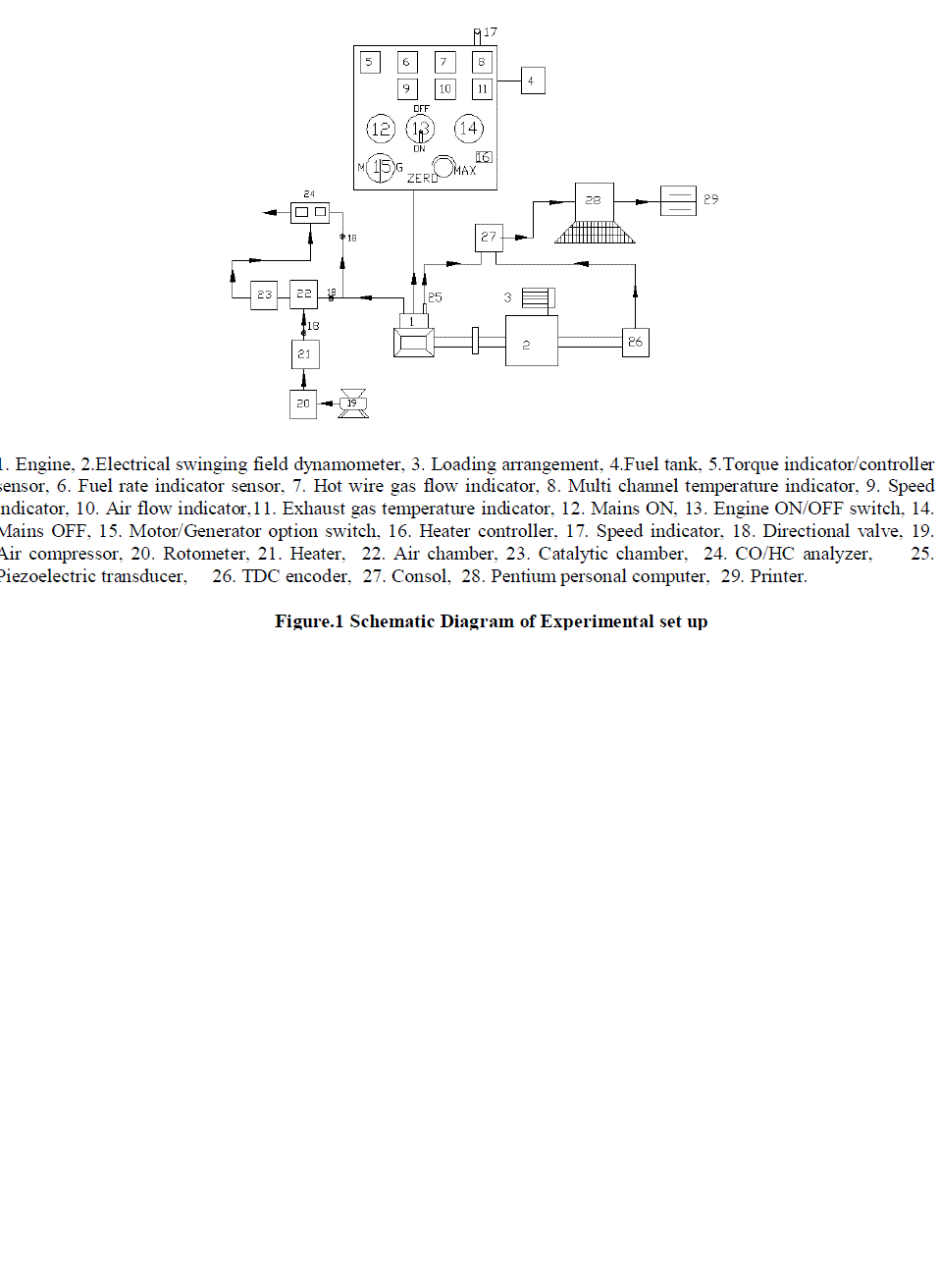 |
| 1. Engine, 2.Electrical swinging field dynamometer, 3. Loading arrangement, 4.Fuel tank, 5.Torque indicator/controller sensor, 6. Fuel rate indicator sensor, 7. Hot wire gas flow indicator, 8. Multi channel temperature indicator, 9. Speed indicator, 10. Air flow indicator,11. Exhaust gas temperature indicator, 12. Mains ON, 13. Engine ON/OFF switch, 14. Mains OFF, 15. Motor/Generator option switch, 16. Heater controller, 17. Speed indicator, 18. Directional valve, 19. Air compressor, 20. Rotometer, 21. Heater, 22. Air chamber, 23. Catalytic chamber, 24. CO/HC analyzer, 25. Piezoelectric transducer, 26. TDC encoder, 27. Consol, 28. Pentium personal computer, 29. Printer. |
| Figure.1 Schematic Diagram of Experimental set up |
RESULTS AND DISCUSSION |
| This section is divided into i) evaluating performance parameters and ii) determination of combustion characteristics. Performance parameters like brake thermal efficiency, exhaust gas temperature and volumetric efficiency were evaluated at different values of brake mean effective pressure. Brake specific energy consumption was determined at full load operation of the engine. Combustion characteristics include peak pressure, maximum rate of pressure rise and time of occurrence of peak pressure determined at full load operation. |
| 4.1 Performance Parameters |
| Figure.3 shows the variation of brake thermal efficiency (BTE) with brake mean effective pressure (BMEP) in different versions of the combustion chamber with test fuels of pure gasoline and alcohol blended gasoline at a compression ratio of 7.5:1 and speed of 3000 rpm. BTE increased up to 80% of the full load operation with an increase of BMEP in different versions of the combustion chamber, with different test fuels. Beyond 80% of the full load operation, BTE decreased with test fuels due to reduction of volumetric efficiency and air fuel ratio. Similar trends were observed by Murali Krishna. Thermal efficiency of two stroke engine is lower as some of the un-burnt charge escape and also due to poor scavenging. Two stroke engines which are scavenged by fresh charge have higher fuel consumption due to opening of inlet and exhaust port at some time and some of fresh charge escapes without doing any work. BTE was observed with alcohol over pure gasoline at all loads due to lower Stoichiometric air requirement of alcohol blended gasoline over pure gasoline operation. Copper coated combustion chamber showed higher thermal efficiency when compared to CE with both test fuels at all loads, particularly at near full load operation, due to efficient combustion with catalytic activity, which was more pronounced at peak load, as catalytic activity increases with prevailing high temperatures at full load. |
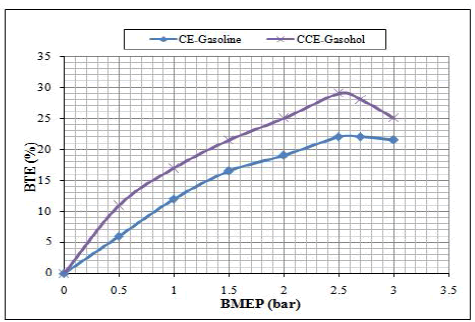 |
| CE- conventional engine: CCCC-Copper coated combustion chamber. BTE- brake thermal efficiency BMEP-Brake mean effective pressure |
| Figure.3. Variation of brake thermal efficiency (BTE) with brake mean effective pressure (BMEP) in different versions of the engine with test fuels at a compression ratio of 7.5:1 and speed of 3000 rpm |
| Figure.4 presents bar charts showing the variation of brake specific energy consumption at full load operation with different versions of the combustion chamber with test fuels. Copper coated combustion chamber showed lower BSEC in comparison with CE with test fuels. This was due to improved combustion with increased catalytic activity with test fuels. Alcohol blended gasoline showed lower value of BSEC in comparison with pure gasoline operation on both versions of the combustion chamber. This was due to lower theoretical air fuel ratio requirement of alcohol blended gasoline so as to improve combustion with improved air fuel ratios. |
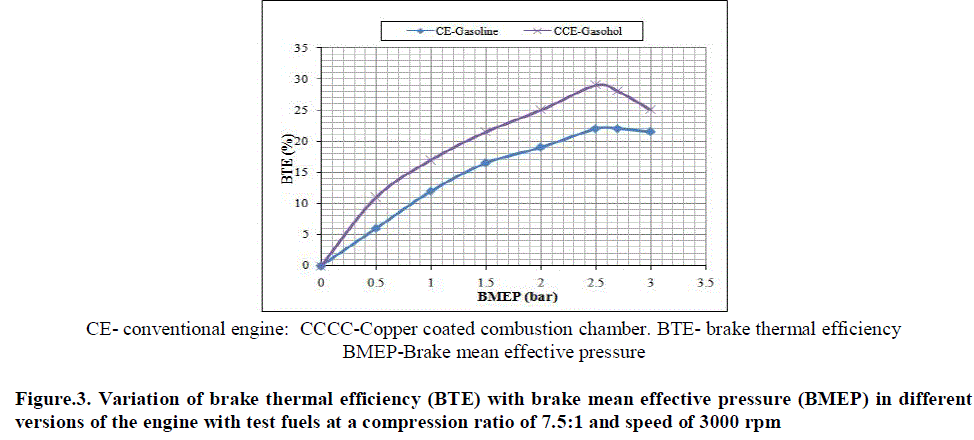 |
| Figure.4 presents bar charts showing the variation of brake specific energy consumption (BSEC) at full load operation with different versions of the combustion chamber with test fuels |
| Figure.5 shows the variation of exhaust gas temperature (EGT) with BMEP in different versions of the combustion chamber with test fuels at a speed of 3000 rpm and compression ratio of 7.5:1, which indicated that EGT increased with an increase of BMEP. This was due to increase of fuel consumption with load. The value of EGT was lower with alcohol blended gasoline when compared to pure gasoline at all loads in CE and copper coated combustion chamber, because, with alcohol blended gasoline, work transfer from piston to gases in cylinder at the end of compression stroke was too large, leading to reduction in the value of EGT. This was also due to high latent heat of evaporation of alcohol blended gasoline. Copper coated combustion chamber registered lower value of EGT when compared to CE for both test fuels, which confirmed that efficient combustion with the copper coated combustion chamber in comparison with CE. |
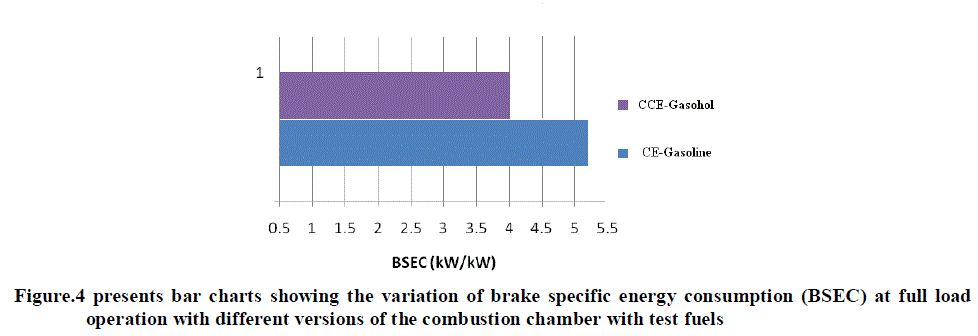 |
| CE- conventional engine: CCCC-Copper coated combustion chamber. BTE- brake thermal efficiency BMEP-Brake mean effective pressure |
| Figure.5. Variation of exhaust gas temperature (EGT) with brake mean effective pressure (BMEP) in different versions of the combustion chamber with test fuels at a compression ratio of 7.5:1 and speed of 3000 rpm |
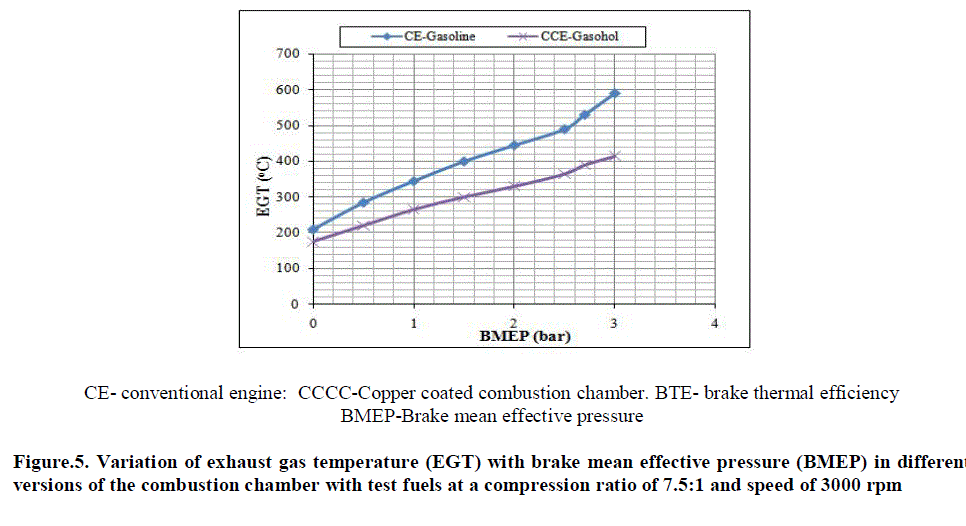 |
| CE- conventional engine: CCCC-Copper coated combustion chamber, BMEP-Brake mean effective pressure |
| Figure.6 Variation of volumetric efficiency with BMEP in different versions of the combustion chamber with test fuels at a compression ratio of 7.5:1 and speed of 3000 rpm |
| Figure. 6 shows the variation of volumetric efficiency (VE) with BMEP with test fuels at a speed of 3000 rpm and a compression ratio of 7.5:1, which indicated that VE decreased with increase of BMEP. Copper coated combustion chamber showed marginally higher VE at all loads in comparison with CE with different test fuels, due to reduction of residual charge and deposits in the combustion chamber of CCE when compared to CE, which shows the same trend as reported earlier[14]. This was also because of lower value of exhaust gas temperatures as volumetric efficiency depends of temperature of combustion chamber walls. Volumetric efficiency increased marginally with alcohol blended gasoline when compared with pure gasoline operation with both versions of the combustion chamber at all loads, due reduction of temperature of air because of high latent heat of evaporation of alcohol blended gasoline. |
| 4.2 Combustion characteristics |
| Figure.7(a) presents bar charts showing the variation of peak pressure with test fuels with different versions of the combustion chamber. Peak pressures were observed to be higher with alcohol blended gasoline in comparison with pure gasoline in both versions of the combustion chamber. Assuming all the fuel enter the engine completely evaporated, the fuel giving largest number of moles of product per mole of reactant should produce the greatest pressure in the cylinder after the combustion, all other factors being equal (which incidentally are not) The greater pressure taken alone would results in an increase in engine power. But an engine may not ingest its mixture with the fuel already evaporated. Under such conditions the number of moles of products should be examined on the basis of number of moles of air inducted since fuel occupies very little volume. Alcohol blended gasoline produced more number of moles of products on dry and wet basis. |
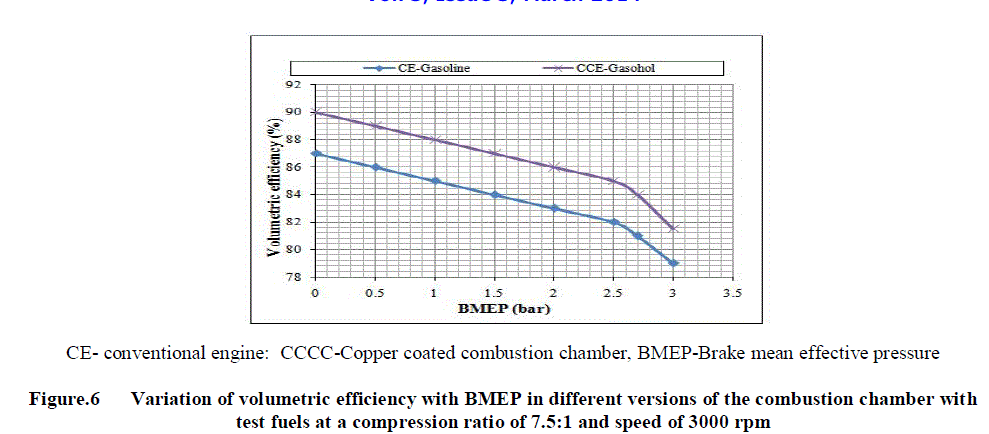 |
| Figure.7 (a) Variation of PP for test fuels for different configurations of the engine |
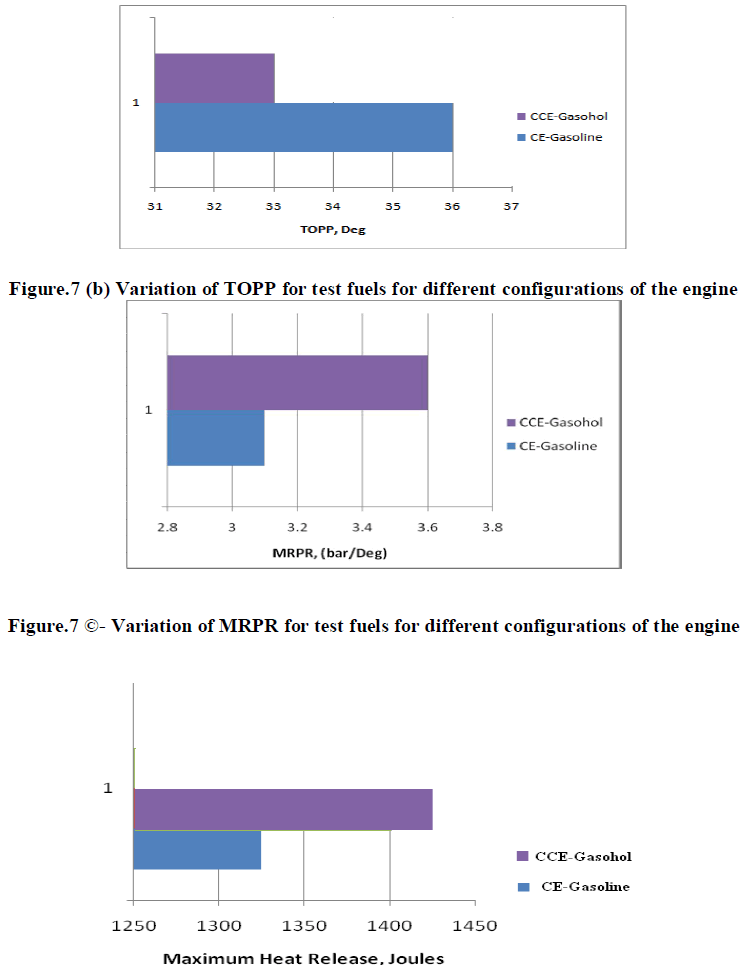 |
| Figure.7 (d) Variation of maximum heat release for test fuels for different configurations of the engine |
| Figure.7- Variation of combustion characteristics for test fuels for different configurations of the combustion chamber. |
| Figure.7 (b) presetns the bar charts showing the variation of time of occurrecne of peak pressure (TOPP) in boht vresions of the combustion chamber with test fuels. TOPP was found to be lower ( nearer to TDC) with CCE with alcohol blended gasoline compared with CE with pure gasoline, which confirms that performane was improved with efficient combustion with CCE. This is because CE exhibited higher temperatures of combustion chamber walls leading to continuation of combustion, giving peak pressures away from TDC. However, this phenomenon is nullified with CCE with alcohol blended gasoline because of reduced temperature of combustion chamber walls thus bringing the peak pressures closure to TDC. CE with gasoline operation exhibited pressure on the piston by the time the piston already started executing downward motion from TDC to BDC leading to decrease PP and increase TOPP. Copper coated combustion chamber with alcohol blended gasoline operation improved combustion due to catalytic activity, PP was oberved to be higher than CE with same test fuel. Higher PP and lower TOPP confirmed that performance of the copper coated combustion chamber with alcohol bleded gasoline operaton improved causing efficient energy utilizaion on the piston. Alcohol addiction improves the combustion process, reduces the crevices flow energy, reduces the cylinder temperature, reduces the ignition delay, speeds up the flame front propagation, and reduces the duration of combustion. The trend followed by MRPR was similar to that of PP as indicated in Figure. 7©. The increase in maximum heat release (calculated from heat release diagram obtained from software package) indicates (Figure.7(d)) that the combustion in the copper coated combustion chamber with alcohol blended gasoline was improved when compared with CE with gasoline due to the combustion of the relatively lean air- fuel mixtures, which shows that combustion was efficient with CCE with gasohol. |
CONCLUSIONS |
| With copper coated combustion chamber, in comparison with CE, |
| 1. Thermal efficiency increased by 9% with gasoline operation, while with alcohol blended gasoline operation it increased by 8%. |
| 2. Exhaust gas temperature decreased by 19%, with gasoline operation, while with alcohol blended gasoline operation it decreased by 5%. |
| 3. Volumetric efficiencies were compatible with gasoline operation as well as alcohol blended gasoline operation. |
| 4. Peak pressure increased by 11% with gasoline operation, while with alcohol blended gasoline it increased by 10%. |
| 5. Both MRPR and TOPP were compatible |
| 6. Maximum heat release rate increased by 2% with gasoline operation, while with alcohol blended gasoline, it increased by 2%. |
References |
|